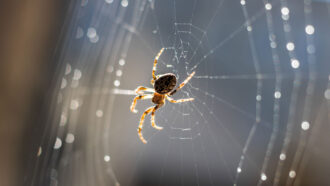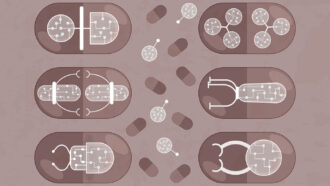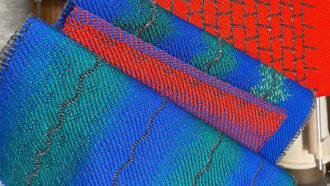Motion and Stability: Forces and Interactions
-
 Animals
AnimalsOrb-weaving spiders use their webs like external eardrums
Scientists discover that orb-weaving spiders listen with their legs, detecting sound vibrations that travel through their silken webs.
-
 Materials Science
Materials ScienceScientists Say: Silicone
Silicone is a generic term for a whole slew of humanmade polymers with many different forms and applications.
-
 Brain
BrainWarning! Nicotine poses special risks to teens
Even a single dose of nicotine during early teen years can start a life-long cycle of nicotine use and addiction.
-
 Chemistry
ChemistryReusable plastic bottles release hundreds of pollutants into water
Data show the plastic ends up tainting drinking water. For now, scientists don’t know what health risks downing these pollutants might pose.
-
 Health & Medicine
Health & MedicinePatches and robotic pills may one day replace injections
Instead of a shot in the arm, a light-activated patch or robotic pill may one day deliver your medicine.
-
 Plants
PlantsElectric shocks act like vaccines to protect plants from viruses
To protect crops against viruses in their home country of Taiwan, two teens invented a novel approach to fight blights.
By Anna Gibbs -
 Chemistry
ChemistryLet’s learn about cellulose
The world’s most abundant natural polymer is finding all kinds of new uses, in everything from ice cream to construction.
-
 Space
SpaceExplainer: All about orbits
A handful of rules can describe the route some object repeatedly takes around another in space. Calculating that path, however, can be quite complex.
By Trisha Muro -
 Materials Science
Materials ScienceThis new fabric can ‘hear’ sounds or broadcast them
With special fibers that convert tiny vibrations to voltages, a new fabric senses sound. Someday, such fabrics could monitor the body or aid hearing.
-
 Materials Science
Materials ScienceLet’s learn about the future of smart clothing
Researchers are fashioning new materials to make clothes more comfortable and convenient.
-
 Physics
PhysicsExplainer: The fundamental forces
Four fundamental forces control all interactions between matter, from the smallest subatomic particles to the largest structures in the universe.
By Trisha Muro -
 Materials Science
Materials ScienceEngineers borrow a tree’s cellulose to toughen new materials
Cellulose gives plants their strength. Engineers are turning this renewable, environmentally friendly resource into brand new materials.